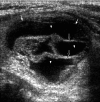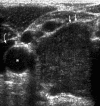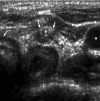Ultrasound of thyroid cancer
- PMID: 16361145
- PMCID: PMC1665239
- DOI: 10.1102/1470-7330.2005.0110
Ultrasound of thyroid cancer
Abstract
The management of thyroid nodules is multi-disciplinary and involves head and neck surgeons, pathologists and radiologists. Ultrasound is easy to perform, widely available, does not involve ionizing radiation and is readily combined with fine needle aspiration cytology (FNAC). It is therefore an ideal investigation of choice for evaluating thyroid nodules. It evaluates specific features that help in identifying the nature of the nodule and FNAC helps in diagnostic accuracy. In addition, following treatment for thyroid cancer ultrasound provides a safe tool for disease surveillance. This paper discusses the role of ultrasound in the management of patients with thyroid cancer.
International Cancer Imaging Society.
Figures



















Similar articles
-
The role of sonography in thyroid cancer.Radiol Clin North Am. 2014 Nov;52(6):1283-94. doi: 10.1016/j.rcl.2014.07.007. Epub 2014 Aug 29. Radiol Clin North Am. 2014. PMID: 25444106 Review.
-
Fine needle aspiration cytology in the management of solitary thyroid nodules--a comparison with other diagnostic modalities in cost-effectiveness.Singapore Med J. 1989 Dec;30(6):557-60. Singapore Med J. 1989. PMID: 2517548
-
Thyroid nodules: Α guide to assessment, treatment and follow-up.Maturitas. 2017 Feb;96:1-9. doi: 10.1016/j.maturitas.2016.11.002. Epub 2016 Nov 9. Maturitas. 2017. PMID: 28041586 Review.
-
Comparison of fine needle aspiration cytology, radioisotopic and ultrasound scanning in the management of thyroid nodules.Postgrad Med J. 1990 Nov;66(781):914-7. doi: 10.1136/pgmj.66.781.914. Postgrad Med J. 1990. PMID: 2176287 Free PMC article.
-
Diagnosis of thyroid metastasis in cancer patients with thyroid mass by fine needle aspiration cytology and ultrasonography.Zhonghua Yi Xue Za Zhi (Taipei). 2002 Mar;65(3):101-5. Zhonghua Yi Xue Za Zhi (Taipei). 2002. PMID: 12051452
Cited by
-
Thyroid hemiagenesis associated with Hurthle cell carcinoma: A case report.Int J Surg Case Rep. 2021 Sep;86:106372. doi: 10.1016/j.ijscr.2021.106372. Epub 2021 Sep 7. Int J Surg Case Rep. 2021. PMID: 34507192 Free PMC article.
-
"Nodule in Nodule" on Thyroid Ultrasonography: Possibility of Follicular Carcinoma Transformed from Benign Thyroid Tumor.Eur Thyroid J. 2017 Apr;6(2):101-107. doi: 10.1159/000452971. Epub 2016 Dec 13. Eur Thyroid J. 2017. PMID: 28589092 Free PMC article.
-
Re-Evaluation of 162 Malignant Thyroid Nodules that were Interpreted as Benign Based on Ultrasound Findings.Ultrasound Int Open. 2018 Oct;4(4):E110-E116. doi: 10.1055/a-0732-5795. Epub 2018 Oct 25. Ultrasound Int Open. 2018. PMID: 30370399 Free PMC article.
-
Imaging for staging and management of thyroid cancer.Cancer Imaging. 2008 Mar 25;8(1):57-69. doi: 10.1102/1470-7330.2008.0007. Cancer Imaging. 2008. PMID: 18390389 Free PMC article. Review.
-
The T4/T3 quotient as a risk factor for differentiated thyroid cancer: a case control study.J Otolaryngol Head Neck Surg. 2017 Apr 4;46(1):28. doi: 10.1186/s40463-017-0208-0. J Otolaryngol Head Neck Surg. 2017. PMID: 28376913 Free PMC article.
References
-
- Tunbridge WMG, Evered DC, Hall R, et al. The spectrum of thyroid disease in a community: the Whickham survey. Clin Endocrinol. 1977;7:481–93. - PubMed
-
- Vander JB, Gaston EA, Dawber TR. The significance of nontoxic thyroid nodules: final report of a 15-year study of the incidence of thyroid malignancy. Ann Intern Med. 1968;69:537–40. - PubMed
-
- Rojeski MT, Gharib H. Nodular thyroid disease: evaluation and management. N Engl J Med. 1985;313:428–36. - PubMed
-
- Rallison ML, Dobyns BM, Meikle AW, et al. Natural history of thyroid abnormalities: prevalence incidence, and regression of thyroid diseases in adolescent and young adults. Am J Med. 1991;91:363–70. - PubMed
-
- Lahey FH, Hare HF. Malignancy in adenomas of the thyroid. J Am Med Assoc. 1951;145:689–95. - PubMed
Publication types
MeSH terms
LinkOut - more resources
Full Text Sources
Medical
